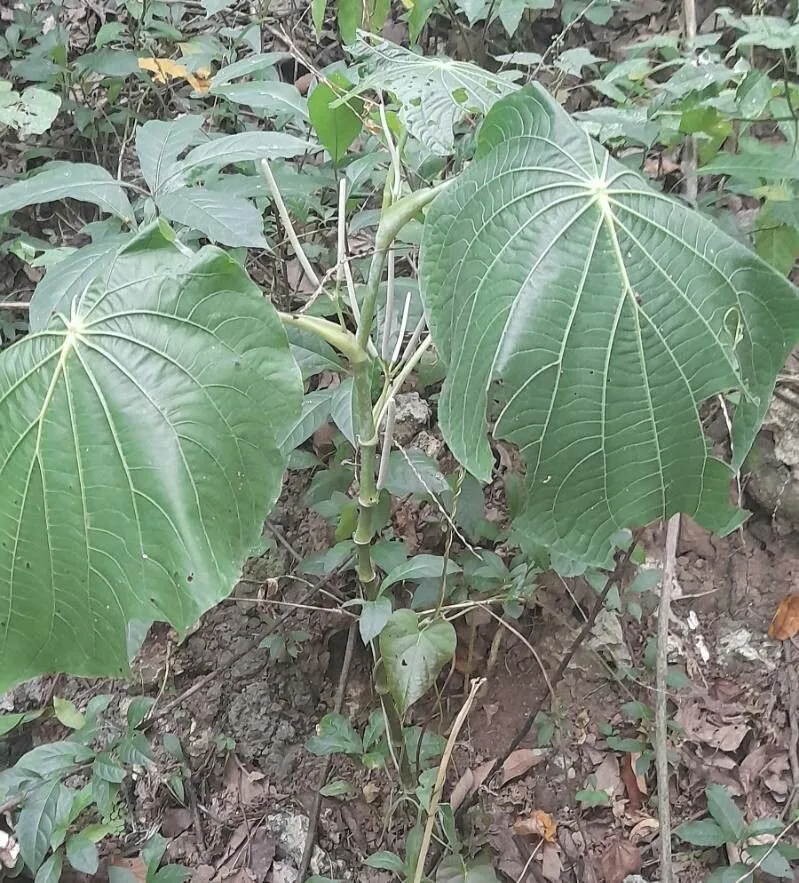
Author: L.
Bibliography: Sp. Pl.: 30 (1753)
Year: 1753
Status: accepted
Rank: species
Genus: Piper
Vegetable: False
Observations: Mexico to Trop. America
Monkey’s-hand, scientifically known as Piper peltatum, is a fascinating plant species that belongs to the Piperaceae family. This unique plant was first described in the seminal work “Species Plantarum” in 1753 by the author Carl Linnaeus, often abbreviated as L.
Piper peltatum is indigenous to various regions ranging from Mexico through Central America and extending into tropical areas of South America. Its presence in such a wide geographical expanse underscores its adaptability to different tropical environments.
Characterized by its notable foliage, the leaves of the Monkey’s-hand plant bear a resemblance to the open palm of a monkey, which likely inspired its common name. These broad, peltate leaves are distinctive and contribute to the plant’s overall appeal both in its native habitat and in cultivated settings.
Piper peltatum thrives in humid, tropical climates and is often found in the understory of forests, where it benefits from the warm temperatures and ample rainfall. The plant’s preference for such environments makes it an excellent indicator of ecological health in these regions.
Overall, Monkey’s-hand is not just a botanical specimen of interest; it plays a role in the ecosystems where it is native, contributing to the diversity and complexity of tropical flora. Its unique appearance and adaptability further highlight the incredible variety found within the Piperaceae family.
Spa: santa maría, cordoncillo
Por: caapeba, capeba, capeba-branca
En: Monkey’s-Hand, Monkey’s hand
Pt: Caapeba, Capeba branca, Capeba, Capeba-branca
Es: Santa María, Cordoncillo, Baquiña, Belladona, Hoja de Estrella, Pañuelitos de Pesebre, Pata de Vaca, Santamaría
Taken Apr 17, 2019 by OTS – R. Aguilar (cc-by-nc-sa)
Taken Jun 23, 2022 by Trap Hers (cc-by-sa)
Taken Jun 23, 2022 by Trap Hers (cc-by-sa)
Taken Jun 23, 2022 by Trap Hers (cc-by-sa)
Taken Jan 20, 2022 by Walter Diaz (cc-by-sa)
Taken Jan 20, 2022 by Walter Diaz (cc-by-sa)
Taken May 31, 2021 by Maria Laura Pizarro (cc-by-sa)
Taken Sep 16, 2022 by Gladys Durán (cc-by-sa)
Taken Apr 17, 2019 by OTS – R. Aguilar (cc-by-nc-sa)
Taken Aug 1, 2003 by Daniel Barthelemy (cc-by-nc)
Taken Jun 23, 2022 by Trap Hers (cc-by-sa)
Taken Jun 23, 2022 by Trap Hers (cc-by-sa)
Taken Aug 1, 2003 by Daniel Barthelemy (cc-by-nc)
Taken May 31, 2021 by Maria Laura Pizarro (cc-by-sa)
Taken May 31, 2021 by Maria Laura Pizarro (cc-by-sa)
Taken Apr 17, 2019 by OTS – R. Aguilar (cc-by-nc-sa)
Taken Jun 23, 2022 by Trap Hers (cc-by-sa)
Taken Sep 28, 2020 by Hélio Hélio Eduardo Lucas (cc-by-sa)
Taken May 31, 2021 by Maria Laura Pizarro (cc-by-sa)
Taken Apr 17, 2019 by OTS – R. Aguilar (cc-by-nc-sa)
Taken Apr 17, 2019 by OTS – R. Aguilar (cc-by-nc-sa)
Taken Apr 17, 2019 by OTS – R. Aguilar (cc-by-nc-sa)
Taken Apr 17, 2019 by OTS – R. Aguilar (cc-by-nc-sa)
Taken Apr 17, 2019 by OTS – O. Vargas (cc-by-nc-sa)
© copyright of the Board of Trustees of the Royal Botanic Gardens, Kew.
© copyright of the Board of Trustees of the Royal Botanic Gardens, Kew.
© copyright of the Board of Trustees of the Royal Botanic Gardens, Kew.
Family: Myrtaceae Author: (F.Muell.) K.D.Hill & L.A.S.Johnson Bibliography: Telopea 6: 402 (1995) Year: 1995 Status:…
Family: Rubiaceae Author: Pierre ex A.Froehner Bibliography: Notizbl. Bot. Gart. Berlin-Dahlem 1: 237 (1897) Year:…
Family: Sapindaceae Author: Koidz. Bibliography: J. Coll. Sci. Imp. Univ. Tokyo 32(1): 38 (1911) Year:…
Family: Asteraceae Author: A.Gray Bibliography: Pacif. Railr. Rep.: 107 (1857) Year: 1857 Status: accepted Rank:…
Family: Fabaceae Author: Medik. Bibliography: Vorles. Churpfälz. Phys.-Ökon. Ges. 2: 398 (1787) Year: 1787 Status:…
Family: Aspleniaceae Author: (Cav.) Alston Bibliography: Bull. Misc. Inform. Kew 1932: 309 (1932) Year: 1932…